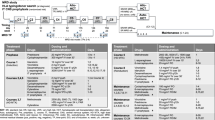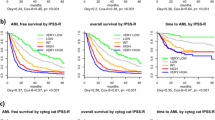Abstract
T cell acute lymphocytic leukemia (T-ALL) and B-precursor ALL differ significantly in the clinical characteristics of the patients at presentation and in laboratory-defined characteristics of the leukemic cells. We assessed for pediatric patients with T-ALL the relative importance of prognostic factors previously demonstrated to predict outcome in B-precursor ALL. Presenting clinical and laboratory features were correlated with outcome for 441 children 12 months to 21 years of age with previously untreated T-ALL, registered on the Pediatric Oncology Group (POG) T3 protocol between 1986 and 1992. These T-ALL prognostic factor analyses were then compared to similar analyses for 1993 patients with B-precursor ALL enrolled during the same time period on the POG ALinC 14 protocol. Quantitative interaction between phenotype and each prognostic factor was studied to determine the relative importance of the prognostic factor for each of the two major immunophenotypes. We also analyzed the importance of maturational stage as a T-ALL prognostic factor, using a modified Ludwig definition of maturational stage. We conclude that several of the clinical and laboratory prognostic factors, which are used reliably for B-precursor ALL, are much less predictive in T-ALL (ie age, WBC, consensus risk group, hyperdiploidy, presence of trans- locations and CALLA expression). There was no significant difference between the phenotypes in the prognostic importance of race or gender. Our data demonstrate a significant difference in outcome among the three maturational stages of T-cell ALL, with the intermediate group faring best. Using traditional risk group criteria to stratify patients with T-ALL for therapy may not be appropriate.
This is a preview of subscription content, access via your institution
Access options
Subscribe to this journal
Receive 12 print issues and online access
$259.00 per year
only $21.58 per issue
Buy this article
- Purchase on Springer Link
- Instant access to full article PDF
Prices may be subject to local taxes which are calculated during checkout
Similar content being viewed by others
Author information
Authors and Affiliations
Rights and permissions
About this article
Cite this article
Pullen, J., Shuster, J., Link, M. et al. Significance of commonly used prognostic factors differs for children with T cell acute lymphocytic leukemia (ALL), as compared to those with B-precursor ALL. A Pediatric Oncology Group (POG) study. Leukemia 13, 1696–1707 (1999). https://doi.org/10.1038/sj.leu.2401555
Received:
Accepted:
Published:
Issue Date:
DOI: https://doi.org/10.1038/sj.leu.2401555
Keywords
This article is cited by
-
T-cell acute lymphoblastic leukemia with atypical intracytoplasmic inclusions in the blasts
Comparative Clinical Pathology (2024)
-
Treatment outcomes of adolescent acute lymphoblastic leukemia treated on Tokyo Children’s Cancer Study Group (TCCSG) clinical trials
International Journal of Hematology (2014)
-
Chromosome abnormalities in T-cell acute lymphoblastic leukemia in Korea
International Journal of Hematology (2014)
-
Philadelphia Chromosome Positive Pre-T Cell Acute Lymphoblastic Leukemia: A Rare Case Report and Short Review
Indian Journal of Hematology and Blood Transfusion (2014)



